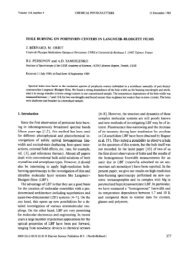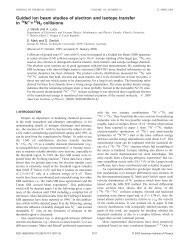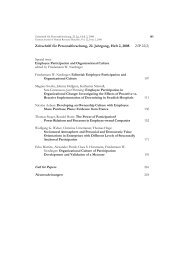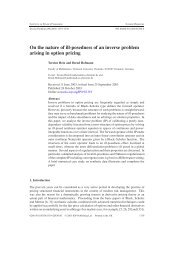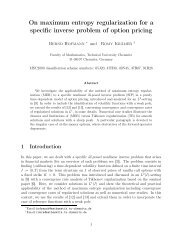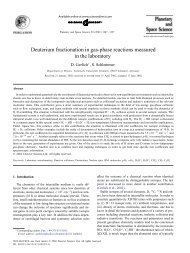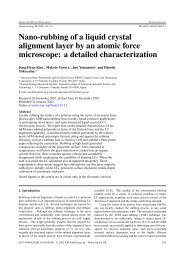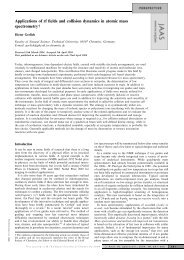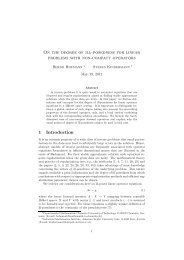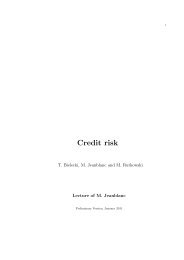Design and Testing of a Low-Cost and Compact Brewster Angle ...
Design and Testing of a Low-Cost and Compact Brewster Angle ...
Design and Testing of a Low-Cost and Compact Brewster Angle ...
Create successful ePaper yourself
Turn your PDF publications into a flip-book with our unique Google optimized e-Paper software.
Notes<br />
<strong>Design</strong> <strong>and</strong> <strong>Testing</strong> <strong>of</strong> a <strong>Low</strong>-<strong>Cost</strong> <strong>and</strong> <strong>Compact</strong><br />
<strong>Brewster</strong> <strong>Angle</strong> Microscope<br />
M. A. Cohen Stuart* <strong>and</strong> R. A. J. Wegh<br />
Department <strong>of</strong> Physical <strong>and</strong> Colloid Chemistry,<br />
Wageningen Agricultural University, P.O. Box 8038,<br />
6700 EK Wageningen, The Netherl<strong>and</strong>s<br />
J. M. Kroon <strong>and</strong> E. J. R. Sudhölter<br />
Department <strong>of</strong> Organic Chemistry, Wageningen<br />
Agricultural University, Dreyenplein 8,<br />
6703 HB Wageningen, The Netherl<strong>and</strong>s<br />
Received September 6, 1995<br />
Introduction<br />
Since its introduction by two groups in 19911,2 the<br />
<strong>Brewster</strong> angle microscope (BAM) has come into widespread<br />
use for the study <strong>of</strong> monolayers, both on liquid <strong>and</strong><br />
on solid surfaces. This is not surprising, as the BAM can<br />
reveal inhomogeneities, particularly phase domains in<br />
ultrathin layers, without the use <strong>of</strong> special probes. This<br />
is a clear advantage over other techniques, such as for<br />
instance fluorescence microscopy, which require the<br />
addition <strong>of</strong> fluorescent probe molecules that may disturb<br />
the local environment <strong>of</strong> the probe <strong>and</strong> thereby cause<br />
artifacts. 3 Since more <strong>and</strong> more monolayer studies on<br />
systems <strong>of</strong> increasing complexity are being carried out, a<br />
BAM should be a compact, easy-to-operate instrument.<br />
Instruments that are presently commercially available<br />
have good performance but are rather heavy <strong>and</strong> relatively<br />
expensive. 4 We have therefore developed a BAM that is<br />
as compact as possible, with high optical quality. In<br />
addition, its construction from st<strong>and</strong>ard optical parts can<br />
be easily realized at moderate cost.<br />
<strong>Design</strong> Objectives<br />
The operation <strong>of</strong> the BAM is based on the well-known<br />
fact that, for a pure Fresnel interface, the reflectivity <strong>of</strong><br />
the in-plane polarization component becomes zero at the<br />
<strong>Brewster</strong> angle. Hence, when a surface <strong>of</strong>, e.g., pure water,<br />
which is an almost pure Fresnel interface, is illuminated<br />
under the Brester angle with monochromatic p-polarized<br />
light, the reflectivity can be as low as 10-7 ; i.e., it will<br />
appear dark. The reflectivity is not exactly zero because<br />
<strong>of</strong> some surface roughness caused by capillary waves. The<br />
presence <strong>of</strong> very small amounts <strong>of</strong> material on the water<br />
surface will affect the <strong>Brewster</strong> condition so that (in most<br />
cases) the reflectivity goes up. Regions differing in density<br />
or orientation <strong>of</strong> molecules on the surface will therefore<br />
show up by virtue <strong>of</strong> their optical contrast.<br />
One problem inherent to the BAM is that the surface<br />
must be viewed under an angle. In a conventional linear<br />
arrangement <strong>of</strong> the viewing optics, it is then impossible<br />
to focus simultaneously on the entire area <strong>of</strong> interest. Only<br />
a narrow strip <strong>of</strong> this area will be in focus; the farther<br />
away surface elements are from this in-focus strip, the<br />
(1) Hönig, D.; Möbius, D. J. Phys. Chem. 1991, 95, 4590-4592.<br />
(2) Hénon, S.; Meunier, J. Rev. Sci. Instrum. 1991, 62, 936.<br />
(3) Lösche, M.; Sackmann, E.; Möhwald, H. Ber. Bunsen-Ges. Phys.<br />
Chem. 1983, 87, 848.<br />
(4) Hönig, D.; Möbius, D. Thin Solid Films 1992, 210/211, 64.<br />
Langmuir 1996, 12, 2863-2865<br />
2863<br />
Figure 1. <strong>Brewster</strong> angle microscope setup. Numbers refer<br />
to the following parts: (1) diode laser including collimator; (2)<br />
dichroic sheet polarizer; (3) CCD camera without lens; (4)<br />
microprojection objective.<br />
more fuzzy they will appear. Moreover, viewing under<br />
an angle obviously yields images compressed along the<br />
line <strong>of</strong> sight. Meunier 2 solved these problems by confocal<br />
scanning <strong>of</strong> the area <strong>of</strong> interest, retaining only narrowstrips<br />
around the focal line. The final image was then<br />
composed <strong>of</strong> these strips after they had been treated<br />
digitally to remove the compression. This leads to good<br />
images, but the disadvantage is that taking <strong>and</strong> processing<br />
the entire image is a time consuming operation, which<br />
requires that imaged objects do not move during capture.<br />
The only way to suppress the collective motion <strong>of</strong> the<br />
molecules at the surface is to use a very small trough<br />
which is protected from disturbing air currents by a cover.<br />
We would prefer an instrument that can be used with<br />
st<strong>and</strong>ard commercial Langmuir troughs, where such<br />
precautions cannot be easily taken.<br />
Another technical difficulty is that reflectivities, even<br />
in the presence <strong>of</strong> molecules on the surface, are very low,<br />
typically <strong>of</strong> order 10 -5 . In order to cope with this, one can<br />
<strong>of</strong> course increase the illumination intensity <strong>and</strong>/or try to<br />
enhance the detection sensitivity. Meunier used a sensitive<br />
CCD camera in combination with an Ar + ion laser,<br />
but the drawback <strong>of</strong> this is a rather bulky instrument.<br />
Last, but not least, care should be taken to avoid<br />
parasitic background contributions from scattered <strong>and</strong><br />
reflected light; these spoil the contrast <strong>of</strong> the image. In<br />
most cases, this problem can be solved by blocking or<br />
absorbing the ray that is refracted into the subphase.<br />
In our design, we wanted to achieve good contrast <strong>and</strong><br />
sensitivity without using heavy or bulky parts. Also, we<br />
wanted to avoid the kind <strong>of</strong> image (re)construction used<br />
by Meunier. Below we describe our setup.<br />
Description <strong>of</strong> the Setup<br />
Our BAM consists <strong>of</strong> a small diode laser (LaserMax<br />
MDL-200-680-35, 34 mm long, 11 mm diameter) which<br />
emits 35 mW at 680 nm. The emitted beam passes through<br />
a polarizer (Melles Griot 03 FPG 001) <strong>and</strong> then illuminates<br />
a spot <strong>of</strong> about 2 mm2 on the surface. The reflected light<br />
passes an objective (which can be chosen according to the<br />
desired range <strong>of</strong> magnification) <strong>and</strong> is finally detected by<br />
a CCD camera (COHU model 6710). Both the objective<br />
lens <strong>and</strong> the CCD camera are somewhat tilted with respect<br />
to the line <strong>of</strong> sight, which partly removes the compression<br />
<strong>of</strong> the final image, while keeping it in focus (Scheinpflug<br />
arrangement). It is this combination <strong>of</strong> a Scheinpflug<br />
arrangement <strong>and</strong> a fairly long focal distance that allows<br />
S0743-7463(95)00759-1 CCC: $12.00 © 1996 American Chemical Society
2864 Langmuir, Vol. 12, No. 11, 1996 Notes<br />
a<br />
Figure 2. Surface pressure isotherm (a) <strong>and</strong> BAM images (b<br />
<strong>and</strong> c) <strong>of</strong> pentadecanoid acid (PDA) on water at pH 3. The<br />
images were both taken at the surface density indicated by the<br />
arrow in part a. Part b was taken immediately after compression;<br />
part c was taken after some extra compression followed<br />
by expansion. Image size: 610 × 920 µm 2 .<br />
us to take the entire image at once without too much<br />
distortion. The camera has its maximal response at 680<br />
nm <strong>and</strong> has a lower detection limit <strong>of</strong> 0.0125 lux. Its output<br />
has 512 horizontal TV lines <strong>and</strong> 415 vertical TV lines.<br />
The observed area at maximum magnification is 500 ×<br />
360 µm 2 , so that 1 pixel <strong>of</strong> the camera corresponds to about<br />
1 µm 2 . The resolution is typically a few micrometers.<br />
Forstoring the data, we have both a framegrabber (Data<br />
Translation DT55-EZ-50), which typically captures about<br />
two images per second, <strong>and</strong> a video recorder, which<br />
operates at 25 frames/s.<br />
Both the light source <strong>and</strong> the imaging optics are<br />
mounted on arms which can be pivoted around the<br />
reflection point, so that the angle <strong>of</strong> incidence can be<br />
adjusted to the <strong>Brewster</strong> angle <strong>of</strong> the substrate used. The<br />
entire microscope is mounted on an X-Y sliding table. With<br />
a<br />
b<br />
Figure 3. Surface pressure isotherm (a) <strong>and</strong> BAM image (b)<br />
<strong>of</strong> dioctadecyldimethylammonium bromide (DODMA) on a 1<br />
mM aqueous NaBr solution. The image was taken at the surface<br />
density indicated by the arrow in part a. Image size: 610 ×<br />
920 µm 2 .<br />
the help <strong>of</strong> this it can be positioned over a usual Langmuir<br />
trough, <strong>and</strong> the surface can be viewed during a (de)compression.<br />
It is best to use a symmetrical trough with<br />
two moving barriers, because in this case the microscope<br />
can be placed in the center <strong>of</strong> the trough <strong>and</strong> the surface<br />
moves only little during (de)compression. The setup is<br />
shown in Figure 1.<br />
<strong>Testing</strong><br />
Two different monolayer forming amphiphiles were used<br />
for testing the setup: pentadecanoic acid (PDA) on water<br />
<strong>of</strong> pH 3 as the subphase <strong>and</strong> dioctadecyldimethylammonium<br />
bromide (DODMA) on 1 mM NaBr. They were taken<br />
on a st<strong>and</strong>ard open Langmuir trough with a total area <strong>of</strong><br />
1100 cm2 , equipped with two moving barriers. The<br />
microscope was positioned in the center between the two<br />
barriers. We show the π/A isotherms <strong>of</strong> both systems<br />
(Figures 2a <strong>and</strong> 3a, respectively), two images <strong>of</strong> PDA<br />
(Figures 2b <strong>and</strong> c), <strong>and</strong> one image <strong>of</strong> DODMA (Figure 3b),<br />
taken in the two-phase range <strong>of</strong> the isotherm at a point<br />
indicated by the arrow. All images have a size <strong>of</strong> about<br />
700 × 550 µm2 .<br />
The first picture taken from the PDA monoalyer (Figure<br />
2b) shows the familiar circular patches that the condensed<br />
phase <strong>of</strong> this molecule forms. 4,5 This shape is expected<br />
for liquid-like phase domains with a sufficiently strong<br />
line tension. The size <strong>of</strong> the patches varies here between<br />
40 <strong>and</strong> 250 µm (cross section), <strong>and</strong> from the length <strong>of</strong> the<br />
plateau in the surface pressure isotherm (from 60 to about<br />
50 Å2 /molecule) we estimate that the density <strong>of</strong> the<br />
(5) Hönig, D.; Overbeck, G. A.; Möbius, D. Adv. Mater. 1992, 4, 419.
Notes Langmuir, Vol. 12, No. 11, 1996 2865<br />
molecules within the patches is approximately 20% higher<br />
than that in the surrounding dilute (LE) monolayer. Since<br />
the intensity <strong>of</strong> the reflected p-wave is to first order linear<br />
in the molecular density, the average contrast in the<br />
picture should be <strong>of</strong> the same order. It can be seen that<br />
such a difference is easily resolved. Note that the patches<br />
do not have a uniform intensity but do have domains<br />
slightly different in intensity. These are probably domains<br />
within the patches that differ in molecular orientation.<br />
Our second image (Figure 2c) was taken after some<br />
expansion. Now the LE phase nucleates within the<br />
patches, forming circular dark holes.<br />
For the condensed phase <strong>of</strong> DODMA we observe a much<br />
more ramified structure, as can be seen in Figure 3b; this<br />
agrees with observations reported by others. 6 Dendritic<br />
structures like these form when the dense phase is solid-<br />
(6) Ahuja, R. C.; Caruso, P.-L.; Möbius, D. Thin Solid Films 1994,<br />
242, 195.<br />
like; they may originate from a diffusion-limited growth<br />
mechanism. Again, the contrast is fairly good, <strong>and</strong> most<br />
<strong>of</strong> the image is reasonably in focus. Details with sizes <strong>of</strong><br />
about 10 µm are readily viewed. Note that we take images<br />
here at the acquisition time <strong>of</strong> the video camera, so that<br />
kinetic studies should be quite feasible.<br />
Conclusions<br />
We have constructed a simple easy-to-operate <strong>Brewster</strong><br />
angle microscope at very reasonable cost that allows us<br />
to study the phase behavior <strong>of</strong> monolayers on st<strong>and</strong>ard<br />
commercial Langmuir troughs. Although there is room<br />
for further improvement, the tests with well-studied<br />
systems show that the setup as presented here is certainly<br />
capable <strong>of</strong> following the formation <strong>of</strong> all kinds <strong>of</strong> surface<br />
phases just as fast as a video camera can operate.<br />
LA9507592




